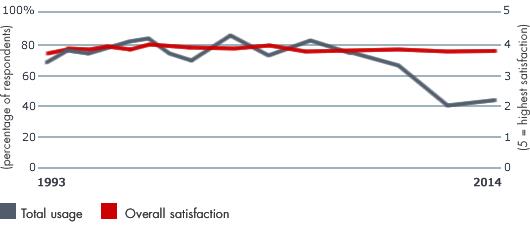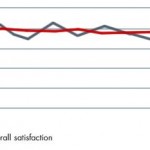Some weeks ago I wrote a post about the Three best pieces of business advice I ever got. That should have been “Four†pieces. I actually forgot another great lesson. So, here is my forth piece of advice, which is about Benchmarking.
Excursus: Benchmarking in the past and today
Benchmarking is known as a management practice that compares the performance of own products or processes with that of best-in-class solutions. The ASQ defines Benchmarking as
Benchmarking is a technique in which a company measures its performance against that of best in class companies, determines how those companies achieved their performance levels and uses the information to improve its own performance. Subjects that can be benchmarked include strategies, operations and processes.
This technique was very popular during the last decades of the 20th century. At that time, businesses faced increasing competition. Accordingly, they looked for strategies to successfully compete in the global marketplace. It was a natural step to look at successful competitors in a systematic way.
Following the changing nature of strategic challenges, benchmarking has somewhat become out of fashion. Managers realized that exceeding best-in-class standards would produce a superior copy in the best case. That wasn’t enough anymore in a VUCA-world of industry disruption and business model innovation.
Of course it is still advisable to have a look at competitors’ products and processes in order to identify areas for improvement. Many businesses still do that with great success. However, adopting others best practices has its risks, as Michael W. McLaughlin states in his article The worst thing about best practices:
They rarely work. A company’s best practices work in the context of its business processes, culture, systems, and people. …
It’s a follower’s strategy. In an era of demands for innovative products and services, why give your clients recycled answers?
Accordingly, the latest Bain Management Tools and Trends Survey reports a significant decline in usage rates for benchmarking:

Usage rates for benchmarking. Image source: Bain, http://www.bain.com/publications/articles/management-tools-benchmarking.aspx
Benchmarking with a twist – still useful today
So forget about old-fashioned benchmarking and look out for a way to disrupt an industry?
It’s not that easy, isn’t it?
I won’t urge you to copy your competitors’ product features or supply chain processes. However, there is another way to look at the concept of benchmarking that is still relevant.
I had a lecture about benchmarking, best practices, continuous improvement and all these ideas during my MBA at the beginning of this century. During that lecture, my professor said
Benchmarking means nothing else than “Copy with prideâ€. That’s all it is about.
Of course, this statement was meant in the old sense of
Look what works well for others and don’t consider yourself above copying it for you.
However, this “Benchmarking – Copy with pride†somehow stayed in my mind. It became a popular quotation in our family. Over time, its meaning changed to everything in the broadest sense of
Look what works well somewhere and try to adapt it to your own situation.
Taking this view into account, “Copy with pride†became very relevant again:
Cross-industry innovation
Today, technology enables you to transfer approaches and business models from one industry to another. You can copy practices from completely different sectors and make them work for you. This is called cross-industry innovation today.
As Vullings and Heleven write in their inspiring book Not Invented Here: Cross-industry Innovation:
Cross-industry innovation is a clever way to jump-start your innovation efforts by drawing analogies and transferring approaches between contexts, beyond the borders of your own industry, sector, area or domain.
“Transferring approaches†is not so far away from “…uses the information to improve its own performance†from the definition of benchmarking above, isn’t it.
You just don’t compare similar processes of products from your own industry. Instead, you are looking completely outside your industry’s box.
Don’t reinvent the wheel
Another way to make “Benchmarking – Copy with pride†work for you is to not reinvent the wheel.
In your day-to-day business activities, you come across many obstacles, problems, and new challenges. It would be extremely inefficient to come up with a great new solution on your own.
Make it a habit to look out if there already is a solution to a similar problem elsewhere. The smart approach is to take this solution and adapt it to your needs. Copy it with pride!
Let me give you an example:
Many copywriters keep a swipe file. A swipe file is a collection of proven and tested headlines or text blocks. When you have to write something, you don’t have to make up everything from scratch. You can flip through your swipe file, take a great sentence or headline and adapt it to your topic.
I did something similar when I was writing the descriptions for our consulting services. I follow a German language blog about writing and blogging. This blogger is an excellent copywriter. He also offers coaching services for other bloggers. I really liked his landing page for that service. Hence, I copied his structure, his way to get the interest of his readers and even the way he bundles his service offer.
I took what obviously worked well for selling a particular service and transferred it to a completely different service.
My conclusion
In my opinion, it is still a viable approach to benchmark against successful approaches. It is no shame to copy what works well for others.
Nevertheless, you should not simply copy other businesses’ concepts one to one. Thus, you would only become a copycat with little differentiation. The real value comes from taking a successful idea as a starting point for you own individual solution.
Thus, benchmarking becomes the success formula for “Copy with prideâ€.
Our book recommendations on benchmarking
- Benchmarking For Best Practices: Winning Through Innovative Adaptation
- Strategic Benchmarking Reloaded with Six Sigma: Improving Your Company’s Performance Using Global Best Practice
- How to Measure Anything: Finding the Value of Intangibles in Business

